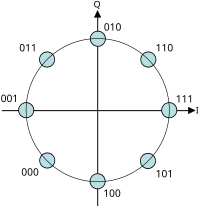In the late 1990s, DVB-S, or Digital Video Broadcasting for Satellite- became more common. A DVB-S uplink is made up of two main parts- the encoding and modulation. Encoding is the process of converting the analog or uncompressed digital video- known as baseband- into a compressed format more easily sent over the limited bandwidth of a satellite uplink. Modulation takes these digital bits and sends them over a radio frequency. The most simple form of digital modulation is Morse code, turning a signal on and off to spell out letters. Modulation used for DVB is far more advanced, and always improving, finding better ways to transmit more data in less bandwidth. A typical uplink in 1998 used QPSK- which stands for Quadrature Phase Shift Keying, where each “symbol” of the uplink signal can represent 4 states for two bits per symbol by adjusting the phase of the RF carrier. DVB includes FEC, or Forward Error Correction, which allows a receiver to produce a error-free output despite noise or other interference. The FEC is expressed as a ratio, from 1/2 to 9/10 being common ratios. 1/2 means 1 out of every 2 bits is a data bit, and 9/10 is 9 out of 10 are data bits, the rest is the error correction overhead. A signal uplinked with 1/2 can be received at much lower levels than 9/10, but the trade off is there is much less usable data available in the channel.
DVB also includes several QAM modes, which changes the amplitude of a signal. Uplinks that use QAM modulation can carry more information in the same bandwidth. There is no free lunch, and the tradeoff of putting more data in less bandwidth is the signal gets harder to receive, and requires larger antennas to “pick up” more of the signal. Just as its harder for your eye to differentiate between 16 shades of a color compared to 4 shades, the same holds true for satellite links. It gets even worse with even higher levels that have more “shades”, such as 64QAM.
Published in 2003, the second generation improvement to the DVB standard, known as S2, was created. DVB-S2 has many improvements over the older DVB-S (now sometimes known as S1). More efficient error correction allows more data at lower signal levels, more FEC ratios to choose the most optimal error correction level, and more modulation constellations to pick from.
8PSK modulation is very common in DVB-S2 uplinks, and allows about 61% more data to be transmitted compared to the same signal in QPSK. However, because of the more efficient error correction, 8PSK requires about the same signal level as DVB-S QPSK! If signal level is an issue, DVB-S2 QPSK works at almost half as strong signal levels as DVB-S QPSK.
DVB-S2 also adds more complex hybrid modulations, such as 32APSK, or 32 level Amplitude and Phase Shift Keying. Unlike QAM, which is very susceptible to noise, APSK combines the better noise performance of PSK with the higher levels available in QAM. Comparing two 16-level constellations- 16APSK and 16QAM, the APSK mode requires 2.6dB LOWER (almost half) power than the QAM signal, and still carries 7% more info.
The 3rd generation standard, DVB-S3 promises to include even higher levels- up to 64APSK- with dozens of FEC choices and tighter “roll off”, making a sharper-sided signal with more usable bandwidth. This comes very close to the Shannon Limit, the maximum amount of data that can be transmitted through a channel.
What does all this mean to you? DCI‘s engineers UNDERSTAND modulation. Unlike companies who simply use the same standards that have been around for 15 years, we know all the tricks and tweaks to make a difficult shot work, or optimize a good shot with incredible quality. While most uplinkers will simply shrug their shoulders if a uplink is breaking up despite maximum power, DCI knows the right adjustments to make. In fact, on a recent flyaway in Los Cabos, when 6Mhz 8PSK was not working, DCI knew the margins would work at QPSK with 12MHz. We can also apply the same technology to save money on sat space. No matter if its a flyaway, satellite uplink truck, or teleport service, let DCI put our extensive know-how and experience to work for you.



